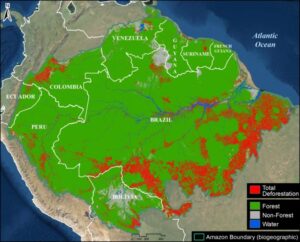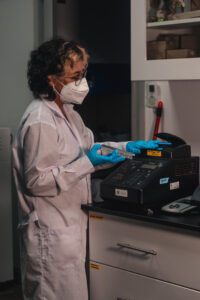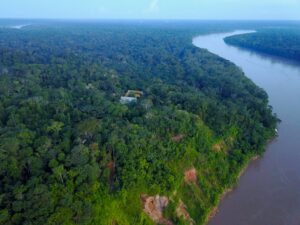Innovating for the Amazon’s Bright Future with Science and Technology
April 14, 2025
In a world of constantly evolving science and technology, Amazon Conservation is at the forefront of harnessing these advancements to develop innovative and long-term conservation solutions to strengthen the management of protected areas and Indigenous territories, while developing effective strategies to halt deforestation and other harmful activities jeopardizing the future of the Amazon.

Since our beginnings 25 years ago, Amazon Conservation has grounded our conservation strategies in science. Early research in the Amazon by world-renowned ecologist and late Amazon Conservation Board Member Tom Lovejoy directly influenced how our co-founders, Adrian Forsyth and Enrique Ortiz, perceived the region’s ecological significance and the urgent need for its protection. Lovejoy led groundbreaking research published in 2018, launching the critical concept of an Amazon’s “tipping point:” the point where deforestation and climate impacts will cause the rainforest to permanently shift from a carbon-rich humid tropical rainforest to a carbon-poor dry savanna. To this day, the tipping point remains a key reference in our efforts to protect this vital ecosystem, highlighting the Amazon’s critical role in regulating the planet’s climate and ecological systems.

To support scientific advancements and on-the-ground research, we established three world-class biological stations in the Peruvian Amazon. Strategically located at varying altitudinal gradients enabling research at distinct elevations, our Los Amigos, Wayqecha, and Manu Biological Stations offer the latest technological and scientific tools for researchers studying botany, genomics, zoology, and more. These stations have housed numerous studies resulting in scientific breakthroughs, such as multiple discoveries of new species, as well as critical insight into the intricate ecological functions of the Amazon’s vast ecosystems and the impacts of climate change. Our biological stations also serve as foundational training centers, advancing the world’s understanding of the Amazon and serving as a model for research experience, immersion for local students, and capacity-building workshops for rangers and leaders from local Amazonian communities to enhance our conservation efforts in the Amazon.

When it comes to technology, one of our most notable innovations is our unique real-time satellite monitoring program, Monitoring of the Andes Amazon Program (MAAP). For the past 10 years, MAAP has served as a vital tool for governments, local and Indigenous communities, policymakers, and social actors to detect and report deforestation as it happens. Over the years, MAAP has continued to utilize new technology to give more accurate, timely, and cost-effective geographic analyses that could not only identify and track deforestation events, but also predict trends in its expansion. This development of MAAP has created a foundation for our close-knit collaboration with national governments, providing critical data on the leading causes of deforestation across the Amazon, which has led to direct field interventions and enforcement that have effectively halted harmful and illegal activities. Furthermore, MAAP has become a key tool within our community-based approach, empowering local authorities and Indigenous communities to track and report illegal deforestation activities in their lands.

By facilitating innovative scientific research and integrating the most advanced technology into our conservation solutions, we are taking an active role in conserving these forests while also empowering a generation of conservationists in the fight to safeguard the Amazon for years to come.
Learn more about how we’re innovating for the Amazon’s bright future >

